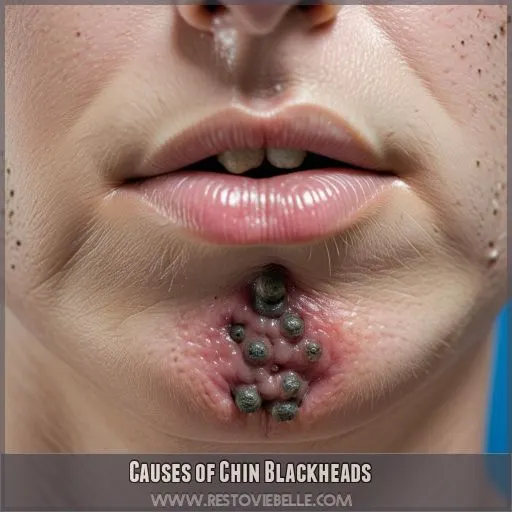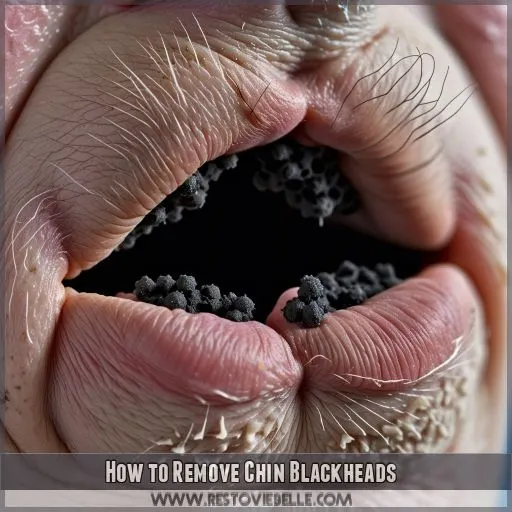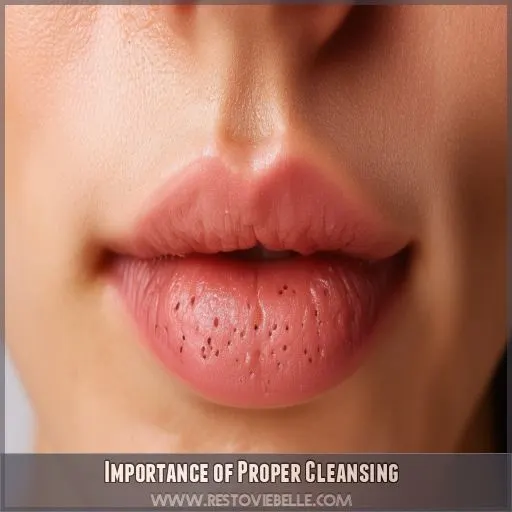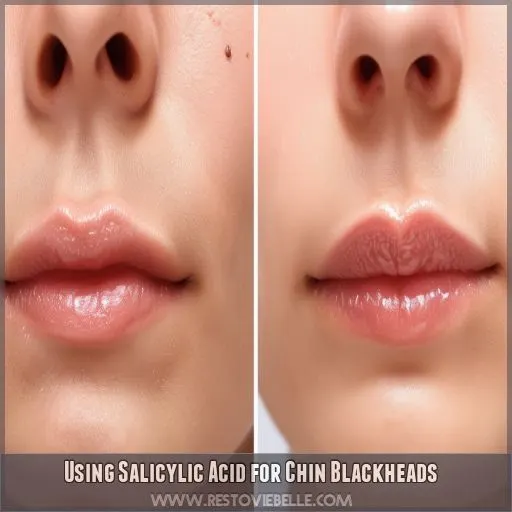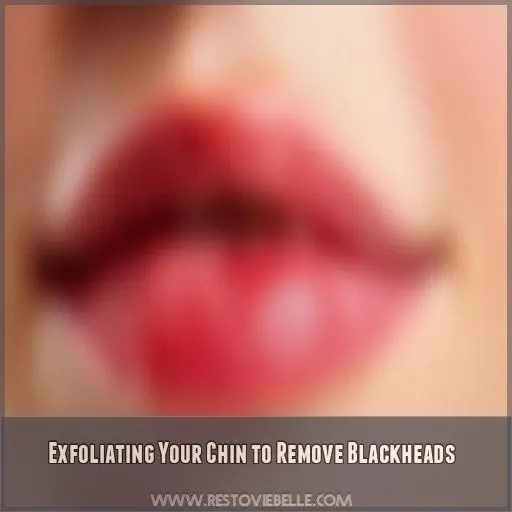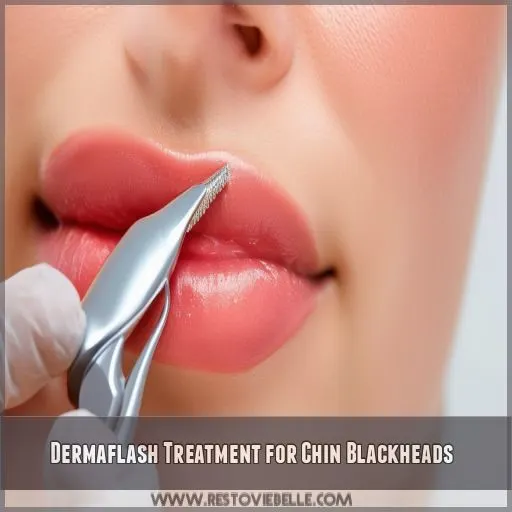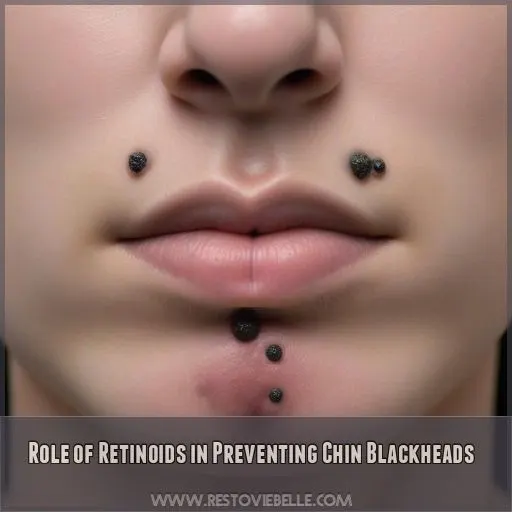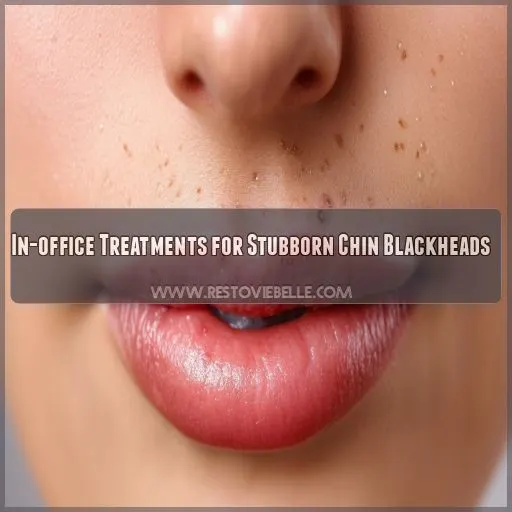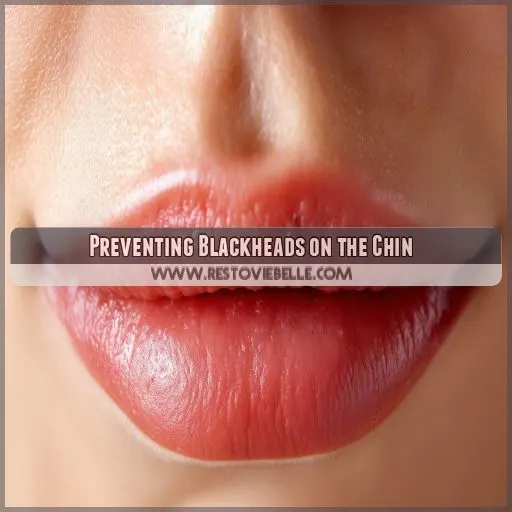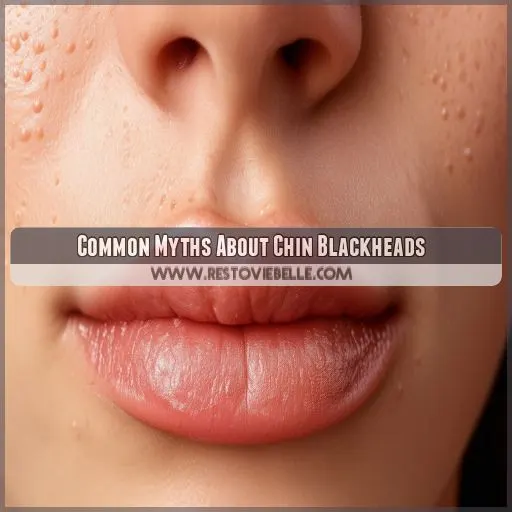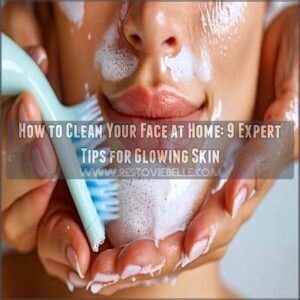This site is supported by our readers. We may earn a commission, at no cost to you, if you purchase through links.
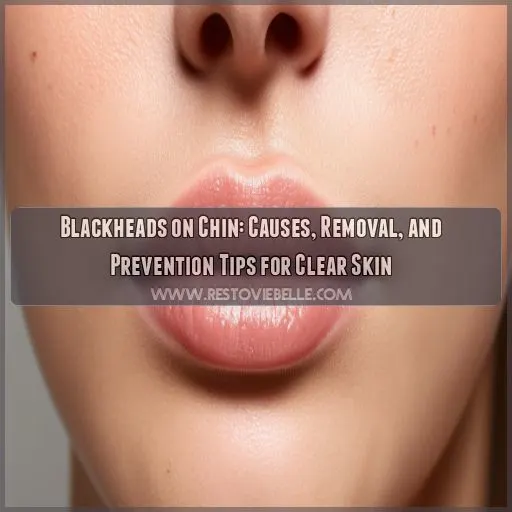 Blackheads on the chin might be one of the most frustrating issues. They appear as excess oil and dead skin cells are clogging up pores, then turning into those dots.
Blackheads on the chin might be one of the most frustrating issues. They appear as excess oil and dead skin cells are clogging up pores, then turning into those dots.
Now, understanding what is at fault—hormonal changes, bacterial growth, and sebum production—is crucial for handling them.
This article includes evidence-based removal tips and prevention strategies for you to help in clear fix skin goals and finally maintain it.
This step-by-step guide gives you power over clarity and control for your skincare.
Table Of Contents
- Key Takeaways
- Causes of Chin Blackheads
- How to Remove Chin Blackheads
- Importance of Proper Cleansing
- Using Salicylic Acid for Chin Blackheads
- Exfoliating Your Chin to Remove Blackheads
- Dermaflash Treatment for Chin Blackheads
- Role of Retinoids in Preventing Chin Blackheads
- In-office Treatments for Stubborn Chin Blackheads
- Preventing Blackheads on the Chin
- Common Myths About Chin Blackheads
- Frequently Asked Questions (FAQs)
- How do I remove blackheads from my chin?
- Why do I suddenly have so many blackheads on my chin?
- What draws blackheads out of your face?
- Should I squeeze blackheads on my chin?
- Can diet affect chin blackheads?
- How long it take to see results?
- Do blackheads on chin indicate other health issues?
- Is it safe to use makeup with blackheads?
- Conclusion
Key Takeaways
- Blackheads on your chin? Don’t let them drive you crazy! Tackle them head-on with these expert tips.
- Hormones, bacteria, and excess oil are the usual suspects behind chin blackheads. Knowing the culprits is half the battle.
- Salicylic acid, retinoids, and exfoliation are your secret weapons for banishing blackheads and keeping them at bay.
- Patience is key! It takes time and consistency to see results, so don’t get discouraged and keep up the good fight.
Causes of Chin Blackheads
The hormonal fluctuations during puberty and adulthood can contribute to increased sebum production, leading to the formation of blackheads on the chin. Additionally, the presence of certain bacteria on the skin’s surface can exacerbate the buildup of dead skin cells and oil within the pores, further aggravating chin blackheads.
Hormonal Influence on Blackheads
Hormonal fluctuations, especially during your menstrual cycle can lead to chin blackheads. Key hormones responsible include:
- Estrogen and Progesterone: Their imbalance increases sebum production.
- Androgens: These hormones heighten oil gland activity.
Bacterial Contribution to Formation
Bacterial inflammation plays a key role in blackhead formation on the chin. An imbalance in skin microflora composition, with an overgrowth of Propionibacterium acnes, can trigger an inflammatory response. Salicylic acid, benzoyl peroxide, and tea tree oil can help manage this bacterial contribution to blackheads.
Role of Sebum Production
Sebum production is pivotal in blackhead formation your chin. Excess oil from overactive oil glands contributes to clogged pores and follicular inflammation. Hormonal imbalances amplify sebum secretion, creating a breeding ground for comedones.
- Overproduction of sebum
- Blocked hair follicles
- Increased keratin levels
- Hormonal fluctuations
How to Remove Chin Blackheads
Now that you know what causes chin blackheads, let’s discuss how to remove them. Start with some over-the-counter treatments like salicylic acid, which breaks down sebum. Home remedies—such as a few drops of worked-in tea tree oil—are also pretty helpful. Consider these:
- Extraction tools: These can be used to extract blackheads safely.
- Pore strips: Good for instant results.
- Spot treatments: Hit blackheads in their tracks.
- Modifications to lifestyle: Ensure a healthy diet and avoid constant touching of the face.
Removing them isn’t an overnight process but a commitment to clear skin.
Importance of Proper Cleansing
Proper cleansing helps in the fight against blackheads on the chin. Cleanse regularly to keep all dirt, oil, and makeup off your skin. Use gentle cleansers that are non-comedogenic, which means they won’t block the pores. Double-cleanse regularly once in the morning and once before bed; this keeps your face clean and prevents any blackheads from forming.
| Routine Step | Product | Frequency |
|---|---|---|
| First Cleanse | Gentle Cleanser | Morning & Night |
| Second Cleanse | Non-Comedogenic Wash | Night |
| Moisturize | Light Moisturizer | Morning & Night |
It all starts with good cleansing for clear skin!
Using Salicylic Acid for Chin Blackheads
Using salicylic acid can really help with head extractions on your chin. It’s a beta hydroxy acid, which will deeply penetrate pores and dissolve sebum while exfoliating dead skin cells. Look for products with a 2-4% concentration.
Combine salicylic acid with an alpha hydroxy acid, such as glycolic acid, to enhance results. Be cautious with ingredient sensitivities and quickly monitor skin reactions for responses.
Duration of effective treatment drastically varies; apply product consistently for several weeks to see improvements.
Exfoliating Your Chin to Remove Blackheads
Exfoliation is a crucial process in removing blackheads from your chin. Start with gentle chemical exfoliants that contain alpha hydroxy acids, like glycolic or lactic acid. Apply it once to twice a week to remove dead skin cells and unclog pores.
Natural exfoliants like sugar or salt scrubs will work fine, too. Overexfoliation is also dangerous as it irritates the skin even further and worsens breakouts.
For a deeper clean, think microdermabrasion and in-office chemical peels. Just remember to follow up with hydrating, non-comedogenic products for that reason alone.
Dermaflash Treatment for Chin Blackheads
The treatment with Dermaflash deeply cleans chin blackheads by exfoliating and removing dead skin cells. Use light pressure; the saying is easy does it, or you’ll have irritation and inflammation.
Don’t overdo it in the beginning; test your skin’s reaction. Be frugal in frequency to avoid over-exfoliation. Keep the cost in mind: treatments have to be done quite often for effectiveness, which can add up.
It’s also important to know the contraindications like sensitive skin or active acne. Key post-treatment point: protect yourself from the sun. When used appropriately, Dermaflash will help prevent whiteheads and clogged hair follicles.
Role of Retinoids in Preventing Chin Blackheads
Moving from Dermaflash to retinoids, let’s get into another critical tool that may help in preventing blackheads on your chin. Popularly known for effectiveness, retinoids regulate skin cell turn-over, reducing sebum production and keeping the pores clean.
- Retinoid efficacy: Has been shown to help shrink blackheads, particularly with consistent application.
- Topical vs. oral retinoids: Topicals are usual; consult a dermatologist for oral forms.
- Retinoid purging: Initial breakouts may develop but normally decrease.
- Retinoid alternatives: Green tea, oral antibiotics, and laser skin resurfacing if necessary.
In-office Treatments for Stubborn Chin Blackheads
For stubborn chin blackheads, consider in-office treatments like microdermabrasion, chemical peels, laser skin resurfacing, and extractions.
microdermabrasion exfoliates dead skin using fine crystals. Chemical peels remove the top layer of skin with acids, promoting new skin growth. Laser skin resurfacing targets deeper layers to unclog pores and reduce oil production. Manual extraction gently removes blackheads under professional care. Blue light therapy can kill acne-causing bacteria and reduce inflammation.
These specialized techniques deliver precise results, effectively tackling persistent blackheads.
Preventing Blackheads on the Chin
Prevention of chin blackheads requires daily habits. Opt for a gentle, non-comedogenic cleanser and face moisturizer with SPF. Apply non-comedogenic makeup and always remove it before bed.
Limit your use of pore strips and face masks as they can irritate the skin. Consistently moisturizing with products suited for acne-prone skin keeps your pores clear.
Keep your hands away from your face to avoid transferring dirt and oil, reducing the likelihood of breakouts. Proper care is your best defense.
Common Myths About Chin Blackheads
While treating blackheads on your chin, one has to be aware of some common myths.
Myth 1: Blackheads are the result of the skin being dirty—cleanliness is important, but the culprits are hormonal and genetic in nature.
Myth 2: Sunscreen causes clogged pores—the reality is applying non-comedogenic sunscreen is very important.
Myth 3: Squeezing blackheads helps.
Myth 4: Blackheads are not merely a form of dirt; the black color comes because the stuff inside gets oxidized.
Myth 5: Scrubbing hard will get rid of them—exfoliate gently.
Frequently Asked Questions (FAQs)
How do I remove blackheads from my chin?
Act the scientist: Cleanse with a2-4% salicylic acid cleanser, apply retinoid night, and exfoliate weekly using glycolic or lactic acid. Avoid picking, and use non-comedogenic products to prevent recurrence.
Why do I suddenly have so many blackheads on my chin?
Sudden chin blackheads can stem from hormonal changes, increased oil production, or clogged pores. Adjust your skincare routine with salicylic acid and retinoids to unclog pores and prevent future breakouts.
What draws blackheads out of your face?
To draw blackheads out of your face, salicylic acid cleansers to dissolve sebum, exfoliate with glycolic or lactic acid a couple of times a week, and apply retinoids to regulate skin cell turnover and reduce pore blockage.
Should I squeeze blackheads on my chin?
Squeezing blackheads might seem satisfying, but you’ll only invite bacteria and inflammation. Instead, opt for products with salicylic acid or retinoids to unclog pores and remove dead skin cells safely and effectively.
Can diet affect chin blackheads?
Yes, your diet can affect chin blackheads. Eating foods high in refined carbs, dairy, and unhealthy fats may increase oil production and clog pores, worsening blackheads. Focus on a balanced, nutrient-rich diet to help keep your skin clear.
How long it take to see results?
You’ll typically see improvement in 4- weeks with consistent use of treatments like salicylic acid, retinoids, and proper cleansing. Some stubborn cases might take longer, so be patient and stick to your routine.
Do blackheads on chin indicate other health issues?
Blackheads on your chin usually don’t indicate underlying health issues. They’re typically caused by excess oil and dead skin cells clogging pores. However, persistent or severe cases may benefit from consultation with a dermatologist for further evaluation.
Is it safe to use makeup with blackheads?
Wearing makeup with blackheads can be a double-edged sword – it may temporarily conceal them, but clogging pores further can exacerbate the issue. Opt for non-comedogenic formulas and diligently remove makeup to keep pores clear and skin healthy.
Conclusion
Get control of those black zits on your chin. Knowing the causes, one could tailor an approach: hormonal changes, bacteria, and sebum.
Efficient cleansing, salicylic acid, exfoliation, and retinoids give effective removal and prevention. In difficult cases, consider dermaflashing and in-office treatments.
Follow these expert-backed tips for getting the clear skin you want. Following these steps will help you take care of blackheads confidently and precisely to make sure that it gives health and clearness to your skin.

